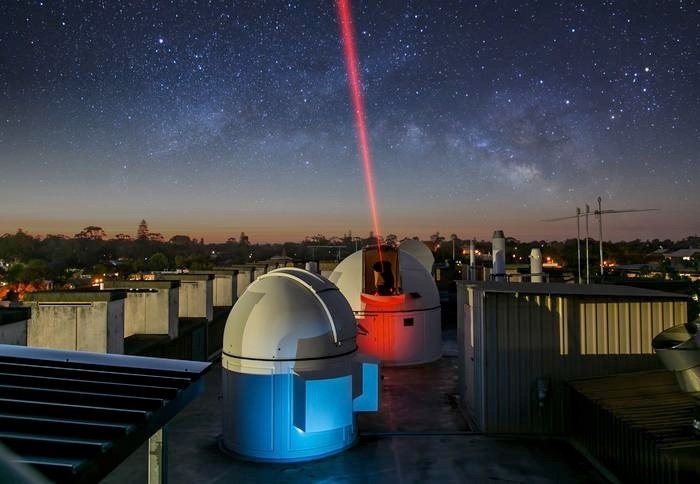Reviewed by Lexie CornerJul 16 2024
A German spacecraft in low Earth orbit has successfully sent laser signals to the University of Western Australia's “TeraNet,” a network of optical ground stations specializing in high-speed space communications. This discovery opens the door to a 1,000-fold increase in Earth-to-space communication bandwidth.
 TeraNet ground stations use lasers, rather than radio waves, to move data. Image Credit: Danail Obreschkow, International Space Centre
TeraNet ground stations use lasers, rather than radio waves, to move data. Image Credit: Danail Obreschkow, International Space Centre
The TeraNet team, under the direction of Associate Professor Sascha Schediwy of the UWA node at the International Centre for Radio Astronomy Research (ICRAR), received laser signals from OSIRISv1, a German Aerospace Center (DLR) laser communication payload.
The OSIRISv1 has been installed on the Flying Laptop satellite at the University of Stuttgart. During last Thursday's satellite flybys, two TeraNet optical ground stations were used to detect the signals.
This demonstration is the critical first step in establishing a next-generation space communications network across Western Australia. The next steps include joining this network to other optical ground stations currently being developed in Australia and across the world.
Sascha Schediwy, Associate Professor, University of Western Australia
Rather than using conventional wireless radio signals, the TeraNet ground stations use lasers to carry data between users on Earth and satellites in orbit. Since lasers operate at frequencies far higher than radio, they can transfer data at thousands of gigabits per second. This means that a lot more data can be packed into each second.
The first satellite, Sputnik 1, was launched around 70 years ago; wireless radio technology has been utilized to communicate from space, and the technology has mostly stayed the same since then. There is currently a severe space bottleneck in the data return process to Earth due to the increasing number of spacecraft in orbit, each of which can generate more data.
This situation is ideal for laser communication, yet there is a drawback: rain and clouds can interfere with laser communications. To mitigate this drawback, the TeraNet team is deploying a network consisting of three ground stations dispersed throughout Western Australia. This implies that the satellite can download its data to a different location with clear skies if conditions are bad at one ground station location.
A specially built Jeep truck also serves as the platform for one of the two TeraNet ground stations that pick up the satellite laser signal. This implies that the station can be quickly installed in locations that require high-speed space communications, including isolated towns where natural disasters have severed traditional communication lines.
High-speed laser communication from space will support secure remote operations for industries like autonomous mining operations and national disaster planning and responses. It will also dramatically improve and secure military communication networks and transform data transfer for Earth observation satellites.
The ICRAR-based TeraNet team received financial support from the Australian Government, the Western Australian Government, and UWA in 2023 as part of the Australian Space Agency’s Moon to Mars Demonstrator Mission grant program. The $6.3 million project supported the construction of the three TeraNet optical ground stations in Western Australia, with the German Aerospace Center (DLR) providing in-kind access to their laser communications-equipped on-orbit satellites.
Using both tried-and-true conventional optical communications standards and more cutting-edge optical technologies, such as deep-space communication, ultra-high-speed coherent communications, quantum-secured communications, and optical positioning and timing, TeraNet will support multiple international space missions operating between low Earth orbit and the Moon.
The network consists of a ground station located at UWA, a second ground station situated 300 km north of Perth at the Mingenew Space Precinct, and a mobile ground station now undergoing commissioning at the New Norcia site of the European Space Agency.